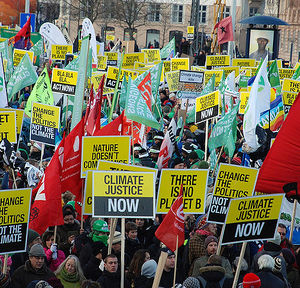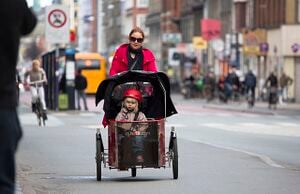
The aim of this page is to recognise, celebrate and encourage the self-empowerment of community agency networks (CANs) and community groups' activism for climate, environment and many other sustainability topics across Malling.
- Blue-sky thinking: how cities can keep air clean after coronavirus...theguardian.com Jun 7, 2020
- How Copenhagen plans to reach carbon-neutral status in just six years...fastcompany.com Aug 20, 2019.
- How do you build a healthy city? Copenhagen reveals its secrets, Feb 11, 2018...The Guardian
Networks and sustainability initiatives[edit | edit source]
Christiania is a famous and controversial experiment in resistance, persistence and self-rule. Despite attracting half a million tourists per year, and being one of the most-visited sites in Denmark, it remains poorly understood by the outside world.
Christiania has long pioneered a more ecological way of life, with a minimum of formal rules, and its DIY urbanism.[1]
Community energy[edit | edit source]
In 2001 a large offshore wind farm was built just off the coast of Copenhagen at Middelgrunden. It produces about 4% of the city's energy.[2]
Climate action[edit | edit source]
The municipal policy is to reduce CO2 emissions by 20% before the end of 2015.
Copenhagen aims to be carbon-neutral by 2025. Commercial and residential buildings are to reduce electricity consumption by 20 percent and 10 percent respectively, and total heat consumption is to fall by 20 percent by 2025. Renewable energy features such as solar panels are becoming increasingly common in the newest buildings in Copenhagen. District heating will be carbon-neutral by 2025. New buildings must now be constructed according to Low Energy Class ratings and in 2020 near net-zero energy buildings. By 2025, 75% of trips should be made on foot, by bike, or by using public transit. The city plans that 20-30% of cars will run on electricity or biofuel by 2025.[3]
Cycling activism[edit | edit source]

Cycling in Copenhagen is – as with most cycling in Denmark – an important mode of transportation and a dominating feature of the cityscape, often noticed by visitors. The city offers a variety of favourable cycling conditions — dense urban proximities, short distances and flat terrain — along with an extensive and well-designed system of cycle tracks. This has earned it a reputation as one of the most bicycle-friendly cities in the world. Every day 1.2 million kilometres (0.75 million miles) are cycled in Copenhagen, with 62% of all citizens commuting to work, school, or university by bicycle; in fact, almost as many people commute by bicycle in greater Copenhagen as do those cycle to work in the entire United States. Cycling is generally perceived as a healthier, more environmentally friendly, cheaper, and often quicker way to get around town than by using an automobile.
Urban sustainability[edit | edit source]
The city's architectural planning authorities have given special attention to both climate issues and efforts to ensure maximum application of low-energy standards. Priorities include recycling rainwater, green roofs and efficient waste management solutions. In city planning, streets and squares are to be designed to encourage cycling and walking rather than driving.
Environment quality[edit | edit source]
Years of substantial investment in sewage treatment have improved water quality in the harbour to an extent that the inner harbour can be used for swimming with facilities at a number of locations.[4]
Open spaces[edit | edit source]
Copenhagen is a green city well endowed with open spaces. It has an extensive and well-distributed system of parks that act as venues for a wide array of events and urban life. As a supplement to the regular parks, there are a number of congenial public gardens and some cemeteries doubling as parks. It is official municipal policy in Copenhagen that all citizens by 2015 must be able to reach a park or beach on foot in less than 15 minutes.
Coasts[edit | edit source]
Copenhagen and the surrounding areas have three beaches with a total of approx. 8 kilometres (5 miles) of sandy shores within 30 minutes cycling from the city centre. These include Amager Strandpark, which opened in 2005 with a 2 km (1 mi) long artificial island and a total of 4.6 km (2.9 mi) of beaches, located just 15 minutes by bicycle or a few minutes by metro from the city centre.
The beaches are supplemented by a system of Harbour Baths along the Copenhagen waterfront. The first and most popular of these is located at Islands Brygge and has won international acclaim for its design.[5]
Food activism[edit | edit source]
Copenhagen Street Food, food market in the heart of Copenhagen
Towards sustainable economies[edit | edit source]
As a result of its commitment to high environmental standards, Copenhagen has been praised for its green economy, becoming the world's leading green city in the 2012 Global Green Economy Index.[6]
Sharing[edit | edit source]
- Sharing Copenhagen, sharing good solutions during 2014
About Copenhagen[edit | edit source]
Copenhagen is recognized as one of the most environmentally friendly cities in the world. W It has also received the title of "European Green Capital 2014" as a result of its environmental record and its ambitious goals.[7] For a number of years, Copenhagen has ranked high in international surveys for its quality of life. Although it is one of the world's most expensive cities, it is also one of the most liveable with its public transport, facilities for cyclists and its environmental policies. W
Near you[edit | edit source]

Freetown Christiania, a partially self-governing neighborhood in the city of Copenhagen, Denmark, which has established semi-legal status as an independent community, was founded in 1971, when a group of hippie squatters took over an area of abandoned military barracks. The proliferation of marijuana in the frontal region of the community, known as Pusher Street, has given rise over the past decade to legal conflict. In response to recent crackdowns and raids by the Danish police, supporters of Christiania have adopted the slogan "Bevar Christiania!" (Save Christiania!).
References


